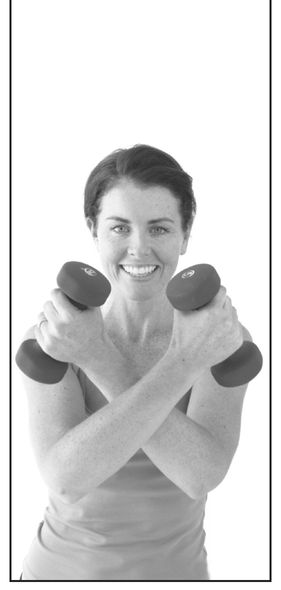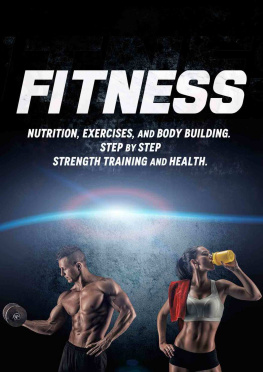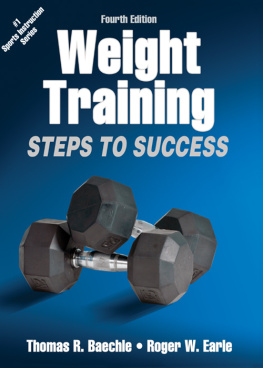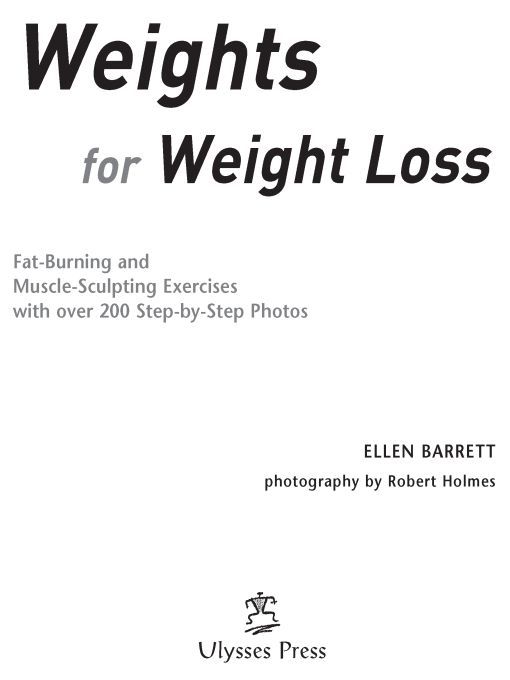Table of Contents
part one:
getting started
introduction
Want to lose weight, look better and feel energized?
Youve picked up the right book! Weights for Weight Loss is about losing weight properly and keeping it off easily. If youre one of the millions of people who yo-yo up and down on the scale, going on and off of diets, this program presents something different. You wont find any speeches here about reducing calories. Rather, this is a modern manual that will show you how to increase your energy output using handheld weights, resulting in weight loss without deprivation.
Throughout my nearly 20 years in the fitness industry, Ive witnessed a lot of workout trends, like aerobics, Jazzercise, step aerobics, tae bo, yoga and Pilates. And Ive seen many diet trends, too, like the grapefruit, the Zone, the Atkins and the South Beach diets. These fads tend to debut with a bang and seem instantly to become part of popular culture. People talk about them at dinner parties and around the water cooler. Theyre featured on the covers of Time magazine and News-week . They achieve Super Bowl status in popularity. Then, the tide begins to turn and the spotlight starts to dim. America seems to telepathically shout, On to the next one!
My reason for writing this is not to discredit other workout and weight-loss techniques. They have all proven effective for some part of the population at some point in time. Someone, somewhere, has found health, wellness and weight-loss success with each of these trends, and thats truly a triumph. We all understand that weight loss isnt easy! Millions of people struggle to lose weight all their lives, and meet with failure again and again. If one of these trends helps even just one person, it deserves a round of applause.
My purpose in mentioning these fad diets and workout trends is to frame an important point about this book. Weight training has never been a hot trend. It has never been all the rage. Its not front-page news. But it has always been here. Weight training is a workout and weight-loss technique that has withstood the test of time. Working out with weights (not to be mistaken for the sport of body building, which debuted in 12th-century India) was around before aerobics and the grapefruit diet, and its still here. In fact, it hasnt even ebbed or flowed in popularity. Its been a consistent part of the fitness world since its birth in the late 1970s. For many soundly fit people, weight training has been and is a true-blue staple. Its refreshing to know that, throughout my entire career, one thing hasnt changed.
I suspect that there are three core reasons for this. First, weight training works for men and women, for all ages, and for every fitness level. Few fitness workouts are so inclusive. Second, weight training offers many variants, so theres less risk of ending up in the workout rut. One can adjust the size of the weight, the angle of the movement, the range of motion and even the sequence of exercises. The countless number of viable routines makes for constant mental engagement and physical challenge. Third, weight training is the epitome of low maintenance. There is no need for large spaces, special clothing, a specific location or big bucks. Weight training is practical, accommodating and cheap. And what great news! Weight training is our user-friendly ticket to lasting weight loss.
The Weight Loss Prerequisite
Before you begin to play the weight-loss game, the one and only prerequisite is simply to make up your mind to take charge of your weight. And because there are two big, controllable variables in the weight-loss gamethe amount of calories you take in and the amount of calories you burntaking charge is easier than you may think. Even though it may not appear so at times, you are very much in control of those numbers on the bathroom scale. From now on, your DNA, your sedentary job and your inability to afford a trainer three times per week are not to be blamed for any weight woes. Explaining this way of thinking to my training clients is a highlight for me because its truly empowering. Youre the C.E.O of Y.O.U., Ive been known to exclaim with conviction. The first step is realizing that the ball is in your court when it comes to losing weight and keeping it off. Your thoughts and actions dictate the outcome. Thats why the first exercise in this book isnt a bicep curl, its a straightforward mental move: You must take responsibility for your weight. Its as easy as making up your mind to do so.


the ABCs of weight loss
The formula for losing weight is actually very simple: Consume less energy than you burn. The way we tend to measure food energy in the body is by counting calories. Just as watts measure electrical energy in a light bulb, calories measure heat energy in the body. I personally dont focus on calories in my everyday life, and I encourage my clients to avoid caloric obsession.
However, for the purpose of this mini science lesson, we must focus on this simple fact: The one and only scientifically proven method for losing weight involves burning more calories than the amount consumed.
Thus, it follows that there are two ways to lose weight. You can reduce your caloric intake or increase your metabolic rate. Eat less, burn more! On paper, the act of losing weight doesnt seem so difficult, does it? But if its such a cinch, then why do millions of people carry excess weight, or lose it only to gain it all back and then some? To answer this question, lets look at the concept of metabolism.
Metabolism
People tend to make the concept of metabolism one-dimensional, thinking its related merely to the intake and use of food. When a person is thin, we generalize and say, Oh, theyve been blessed with a fast metabolism. When someone struggles with their weight, they may complain, I have a sluggish metabolism. While all of this may be true, its not the whole story. Metabolism has three major components that are advantageous to recognize.
Basal Metabolism Rate: Also known as the resting metabolic rate, the basal metabolism is the energy used when the body is at complete rest. It involves the calories used to keep all systems going day in and day outthe calories burned by the brain, heart, kidneys and all organs and cells in the body. About two-thirds to three-quarters of the calories we burn everyday are accounted for in basal metabolism. The basal metabolism is closely related to ones muscle mass, so we actually have a bit of control over our basal metabolism in that we can increase our own muscle mass.
Active Metabolism Rate:













